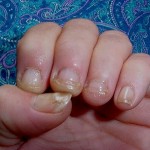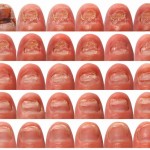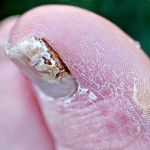When you have a nail fungus, fungi affect one or more of your nails. This condition often occurs in people who wear acrylic nails, because fungus causing moisture gets trapped underneath the nails. Acrylic nails are a wonderful way to achieve elegant, beautiful nails of any length without performing the daily rituals that require natural nails. Among all artificial nails, acrylic nails are stronger and last longer than other artificial nails. They are safe if applied by professionals toilet. However, using unsanitary of them or their overuse can lead to fungus acrylic nails.
 Acrylic nail fungus does not harm the acrylic nail, the fungus does not infect artificial nails, it infects the natural nail or skin around or below the natural nail. Usually, people use to cover warped, broken, discolored or brittle nails. Since nail fungus can cause pain and look unsightly, you’ll want to treat the condition.
Acrylic nail fungus does not harm the acrylic nail, the fungus does not infect artificial nails, it infects the natural nail or skin around or below the natural nail. Usually, people use to cover warped, broken, discolored or brittle nails. Since nail fungus can cause pain and look unsightly, you’ll want to treat the condition.
Causes
- The application requires a thickening of acrylic nails, modification and extension its natural nails. This fungus can cause infection between the layers. The use of nail polish on acrylic nails, produces moisture which gives
a chance for fungi to grow. - Causes of acrylic nail fungus can be the tools used by the professional polish. They often use the same tools to all their
customers without a good routine cleaning or disinfecting. Everyone is vulnerable to the fungi in these tools. - Another cause of nail fungus acrylic nails artificial rose. Generally this is likely to occur when you apply these nails by yourself. When the nails are removed or not properly installed on natural nails, water readily available, providing a breeding ground for infection. Fungus grows in the presence of moisture, heat and darkness. Thus, the space formed between acrylic nails and nail home is an ideal environment for fungus to grow. Thus, the nails are ill-fitting one of the main causes of fungus acrylic nails.
Symptoms:
- The first sign is a yellowish or white spot under the nail tip .
- Natural nail may appear distorted.
- They may also lose their natural shine and begin to appear discolored.
- Your nails become brittle, leading to break or ruin.
- The color of the skin around your natural nails can be discolored.
- If above symptoms are neglected and not treated in time, then the nail may separate from the nail bed, onycholysis.
Treatment
- Remove the acrylic nails. Your first step will involve getting rid of your fake nails. If allowed to cover the infection, you
can worsen the condition. Ask a reputable nail salon to remove the nails. - Trim the nails. After taking off the fake nails, trim your natural nails short and in a straight line. Leave off nail polish in
order to allow the nails to heal properly. - Use an anti-fungal nail lacquer. If you have a nail fungus, you should see a doctor regarding treatment. He may recommend
Penlac, a nail polish that treats fungus when painted on infected nails and surrounding skin. - Get a prescription for an oral antifungal medication. Although medications may not always clear up nail fungus right away, they can help prevent the infection from spreading and worsening. Your doctor may suggest you take Diflucan for 6 weeks or more.
- Inquire about fingernail removal. If the nail fungus is severe, your doctor may suggest removing your real nail and waiting
for the new one to grow back. - Tea tree oil has the ability to kill fungal growth and facilitates infection. So, apply tea tree oil on the affected nail and skin
around it. - White vinegar and apple cider vinegar treatments are very popular. Soak your infected nails in the solution daily for about 30 minutes really helps.
- Listerine mouthwash works like magic for the treatment of nail fungus. Daily for 30 minutes, soak the affected finger in it.
- Apply different essential oils like olive oil, lavender oil, jojoba oil, etc. which are known to healers and soothers . These natural oils have the power to eradicate the fungus and also help heal wounds.
-
Do not expect to see results overnight. These treatments can last between six months to a year depending on your body. However, the initial improvement may be noticed within 8 weeks.
What to look for
All cosmetologists must be licensed, the salons must be licensed, and licenses must be displayed or immediately available upon request.
In mass production shops, there are usually 6-10 tables and only three people working. Those three people are usually the only ones licensed, said Cathy Prusinski, a nail technician at Creative Designs in Bourbonnais, who has visited other shops to see their techniques and ask questions.
(To be continued in Part 2)


